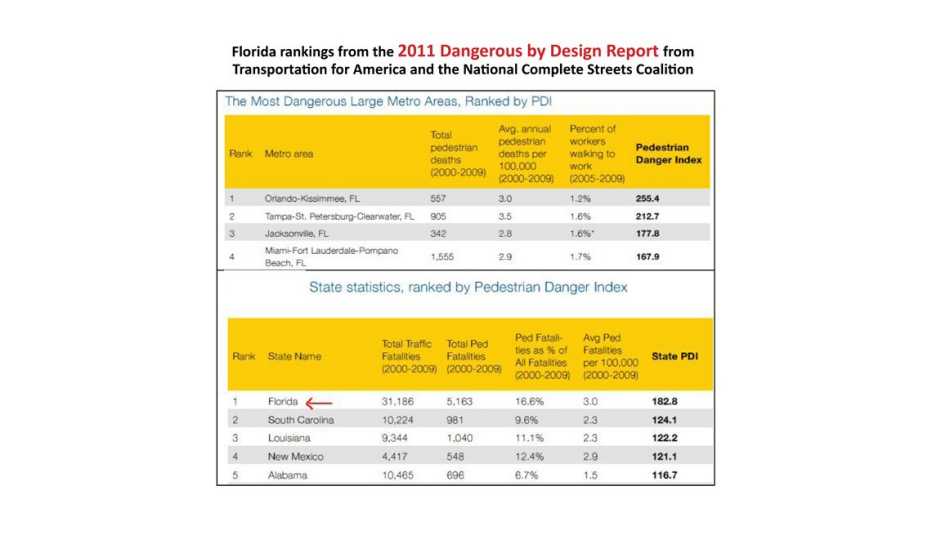AARP Hearing Center


In 2011 and then again in 2014, four metropolitan areas in Florida — namely, Orlando, Tampa, Jacksonville and Miami — ranked among the five most dangerous places in the United States to be a pedestrian or bicyclist.
The unwelcomed achievement came from the Dangerous by Design reports issued by the National Complete Streets Coalition.
"Complete Streets" take into account the needs of all users — whether they're traveling in a car or a bus, on a bicycle or by foot. While a high-speed interstate needn't be designed to accommodate pedestrians or cyclists, a residential neighborhood or a commercial area with retail destinations and services should.
Although the state took the 2011 ranking seriously and started working to mend its dangerous roadways, the second report "showed no improvements because the data used for the 2014 report came from 2012, which is when we began getting our efforts up and running," explains Billy Hattaway, District 1 Secretary for the Florida Department of Transportation. (Florida's state DOT is decentralized and divided into seven geographic districts.)
At the end of 2014 Hattaway was named "Public Official of the Year" by Governing magazine. The opening of that article succinctly and effectively captures his story:
"When Billy Hattaway took a 10-day trip out to the West Coast in 1996, it triggered a 'conversion experience' for the then-state roadway design engineer at the Florida Department of Transportation (FDOT). He toured cities with roundabouts and other pedestrian-friendly infrastructure features — rare sights in the Sunshine State. After returning, he began pushing Florida to adopt some of the walkable ideas he'd seen. He got nowhere. Frustrated by his state's lack of action, he later left to become a private consultant, assisting other states instead."
Hattaway proved to be ahead of his time. He was rehired by the state in 2011 to lead FDOT's District 1, which covers the Southwest portion of the state. His encore mission has been to make more of Florida more pedestrian and bicycle friendly.
Ironically and appropriately, FDOT is being helped with its efforts by Smart Growth America, which is the parent organization of the National Complete Streets Coalition. ("It’s pretty neat that the people who basically wrote us up [for being the most deadly state have now] facilitated our Complete Streets policy," Hattaway said in 2015.)
Since returning to FDOT Hattaway has worked to develop Florida's first-ever statewide strategic safety plan for walking and bicycling. He's led efforts to train transportation planners and engineers in walk-bike-friendly road design and he's working to revise the technical documents and guidelines that are used when roads are being constructed anew or redesigned.
AARP is a strong advocate for Complete Streets (also called "Safe Streets.") Billy Hattaway spoke with Laura Cantwell, associate state director of AARP Florida. — Melissa Stanton, editor, AARP.org/Livable
1. To set the stage, please give an overview of Florida's transportation-related pros and cons.
The biggest reason for our efforts here, at Florida DOT, was the 2011 report by Smart Growth America called Dangerous by Design. The state didn't rank very well. Improvements were very necessary. [Editor's Note: See the chart below to learn about Florida's 2011 rankings.]
We started by basically redefining our entire bicycle and pedestrian program. Doing so required a lot of organizational change in the districts and in [the state capital] Tallahassee. None of the state's districts had a dedicated, full-time bicycle and pedestrian coordinator, so we established dedicated coordinators in every district to deal with the planning and design and to work on the program development side. We also added a bike and pedestrian safety specialist in each district to deal with our existing safety problems.
All of this came about as a result of specialists we brought in from the National Highway Transportation Safety Administration. Out of that came our first strategic safety plan for bicyclists and pedestrians.
That plan has guided the safety initiative side. And we've been working on not just the four regions that were identified among the nation's top five most dangerous metropolitan areas for pedestrians and bicyclists, but we're working on our top 15 counties in terms of a focused safety initiative. Once we established the safety initiative we began working with local governments and funding their enforcement and education efforts.
In the fall of 2014 we adopted the state's first Complete Streets policy. Working with Smart Growth America, we had our implementation plan underway by March of 2015. A policy without an implementation plan will not create the needed change.
2. What is the "Complete Streets Implementation Plan M2D2: Multimodal Development and Delivery" and why is it of national significance?
The M2D2 is Smart Growth America’s term for the technical assistance they provide to state DOTs to implement Complete Streets policies. We're the third state they worked with after Michigan and Vermont. Smart Growth received a Rockefeller Foundation grant and we were given more than $250,000 worth of services to do the implementation plan.
There's no way we could have gotten to where we did, in the time frame we did, without Smart Growth's support. They facilitated what we called our Complete Streets Implementation Team, which was made up of representatives from all seven of our geographic districts as well as a lot of stakeholder groups from cities and counties that were very progressive on these fronts and had probably experienced a lot of frustration with us as an agency.
The Complete Plan
When we talk about multimodal and Complete Streets it means really looking at every corridor and every street in our system to understand who the dominant users are and whether we're accommodating their needs.
People think Complete Streets is just about adding sidewalks and bike lanes. But if we have a dedicated corridor, say, going from our interstate system to one of our major ports, we should be making sure that the corridor adequately serves the freight movements that are occurring. But mostly, when you look at our system and where the shortfalls are related to Complete Streets — which means providing for all users — our focus has been on how vehicle lane widths, sidewalks and related infrastructure has been inadequate in serving pedestrians and bicyclists.
On the plus side, before we even finished working on our Complete Streets implementation plan, we had already reduced our lane width requirements from 12 feet, for speeds of 45 miles per hour and less in our metropolitan and urban areas, to 11 feet. Instead of a 4-foot bike lane we've developed a 7-foot buffer lane as our standard bike lane width.
3. Were there any "a-ha" moments among participants during the M2D2 workshops?
We had people there representing a wide range of technical areas and areas of responsibility from planning all the way through maintenance and construction and operations. I think a lot of people had "a-ha" moments because, for many of them, it was the first time they had been exposed in a very holistic way to all of the other parts of our business.
For the people in the design side of our business, seeing things and hearing from the experts Smart Growth America brought in to help educate and facilitate the discussion got a lot of attention.
Our first session was in March of 2015 and we finished the final report that November. We adopted the implementation plan in early 2016 and we're in the process of updating and re-writing our design guidance and policies from program development all the way through design. This is a dramatic change for our agency and it will be for any other state DOT that moves in this direction. What we're doing is a dramatic culture change.
4. AARP surveys consistently find that people want to remain in their communities as they age, but many communities are designed for getting around almost entirely by car. If a resident is unable to drive, the options for getting out and about are minimal or non-existent. How does the Florida Complete Streets plan acknowledge and address that issue?
Land development patterns have a huge impact on what happens and the Complete Streets movement cannot succeed without local governments dealing with their land development patterns — and that includes such issues as disconnections between adjacent developments, whether residential or commercial, and having buildings set back hundreds of feet from the road. For someone who doesn't drive, installing a sidewalk and a bike lane isn't very useful when they live in an area that's physically isolated from where their needs have to be fulfilled.


Incomplete Streets
Look at the photos and read about what you see in our award-winning slideshow. Then think about the roadways near you. There's a good chance you're encountering similar sights and scenes.
That's part of why I live in downtown Orlando. My wife and I plan to retire in place and we can. We can walk to the grocery store. Our health care providers, credit union and on and on are all within walking or bicycling distances.
Pedestrian mobility problems can't be fixed entirely by a state Department of Transportation or, really, any transportation group in the city or county until the local governments start to change their land development patterns.
Despite our efforts, the situation is not going to change overnight. So much of Florida's land development patterns occurred after World War II. The state experienced a lot of growth that featured a lot of development that doesn’t support walking and bicycling.
However, there are opportunities through redevelopment to rebuild portions of communities to be more supportive to those needs. Our plan has recommendations that will provide guidance on retrofitting communities.
5. What advice would you give to other states and municipalities that are seeking to implement Complete Streets policies?
I think all of us need to be thinking about how we want our communities to work for the long-term. We need to be more aware of the implications of our future land development patterns. Local governments especially need to be thinking more about what the long-term demands are and will be for future generations.
Millennials and other younger generations don't want to live in the same land development patterns their parents or grandparents lived in. I have two millennial children and neither lives in suburban sprawl. In fact, my 35-year-old son hasn't had a car for a year now. He lives in South Beach and uses Uber to get around or the Red Coach bus service when he comes to see us in downtown Orlando.
Change is difficult is for everyone. As an agency, the Florida Department of Transportation is certainly changing and I think our Complete Streets policy and the implementation plan reflect that. Soon after our new Complete Streets handbook is published we'll begin training our employees, local government staff, elected officials and the consultant industry on our new planning and design guidance.
That said, we still have a lot of developers and elected officials who don’t understand that there's a changing demand for how people want to live. Many cities and counties and DOTs aren't moving fast enough in that direction. Those that are are interested in implementing Complete Streets policies should consider using Smart Growth America in developing their implementation plans. They should also take advantage of the training we'll offer as part of our handbook implementation.
Published July 2016
You May Also Like

































































